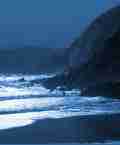 |
Search the site:

The Cauldron in Celtic LifeThe cauldron played a significant part in both Celtic life and belief. As a symbol of well being, it pre-dated the Celts by many thousands of years; from the early Bronze Age of pre-Celtic Europe, bronze vessels were used in both feasting and ritual and appear to have been specifically associated with the dead. From about the second millennium bc, they were used as cook-pots, perhaps for boiling meat and for heating water or drink. The feasts would probably have been great tribal occasions, as the cauldron would have produced such large quantities. Some cauldrons unearthed hold between 14 and 17 gallons – hardly a family cooking pot.Many of the monstrous pots have been found in Ireland, Scotland and in Brittany. Such mighty cauldrons were also associated with the dead and seem to have formed an important part of Irish funerary rites. Some seem to have been used as vehicles, perhaps for transporting the dead from one world into the other. Carried on a cart mounted on wheels, as in representations of the Urnfield vessels, these massive containers carried the remains of the dead, sometimes burned and charred, out of the mortal sphere. In parts of Iron Age Scandinavia, the vessels were located primarily in watery contexts, such as Gunstrap [Gundestrup]. The symbol of the cauldron, both as representation of rebirth and as source of continuous abundance, looms large in Irish mythology. Each Irish ‘bruidhean’ – Otherworld hostel or ‘house of the god’ – had its own magical pot that could easily feed one hundred warriors and never became empty. Such inexhaustible cauldrons also regenerated dead warriors. This accorded with the dual notions of feasting and revitalisation, believed common among Celtic warrior cults. In Irish mythology, the Daghdha, the father of all the gods in the Irish pantheon was supposed to own a cauldron that overflowed with foodstuffs, beer and whiskey. The Daghdha was widely regarded as a god of fecundity and plenteous living; his cauldron was a symbol of this and also conformed to the Irish idea of hospitality. The club that the Daghdha reputedly carried, that could raise the dead, corresponded to the notion of the cauldron and warfare. The Daghdha's pot was so large that it could make a porridge that contained the whole carcasses of sheep, pigs and goats and eighty measures of milk and fat. It was regarded as the Celtic equivalent of the Viking ‘Horn of Plenty’, which the supreme Norse god Odin and his son Thor alternately held. The hungry Cú Chulainn and his friend Cú Roí, whom he later kills, went on a hunt for Muirias, the legendary cauldron of the Daghdha. They managed to steal it from a mysterious castle: a foretaste of the later Arthurian quest with its eerie castle of the Fisher King. Another Celtic monarch known as Midir the Proud owned a magic cauldron that he was supposed to have brought back from the Otherworld after a similar quest. Journeys of discovery involving supernatural cooking pots are to be found in vernacular Welsh sagas such as The Spoils of Annwn. The cauldron held a special place in Celtic society and was therefore often invested with supernatural properties. It was also an essential part of the stereotypical witch's magical baggage. Within the cauldron, all kinds of powers ebbed and flowed, lending a mystical force to whatever was cooked or mixed in it. As the symbol of mystery and death, it was emblazoned on the Celtic mind.
From the Appletree Press title:
|
[ Back to Top ]
All Material © 1999-2005 Irelandseye.com and contributors

